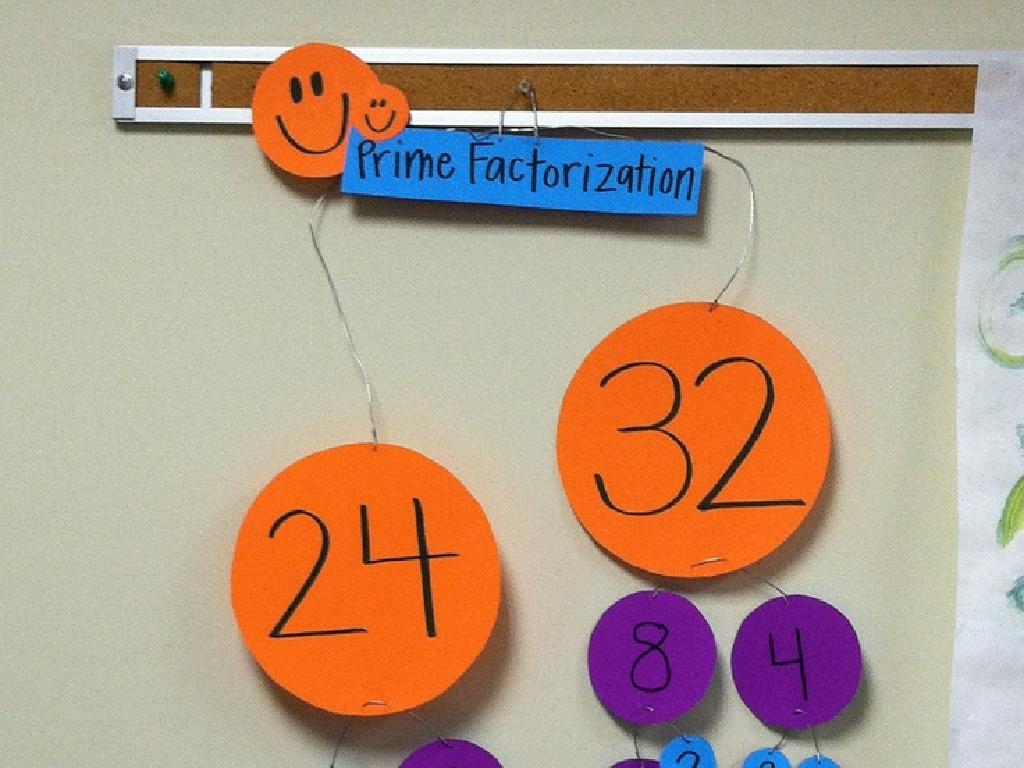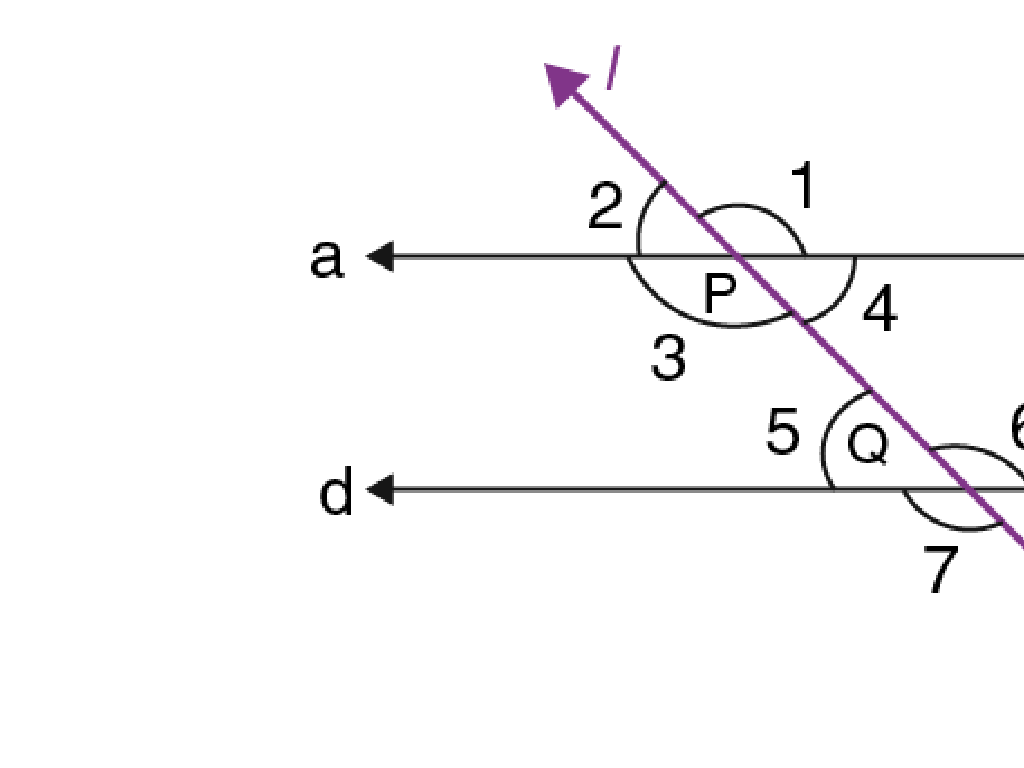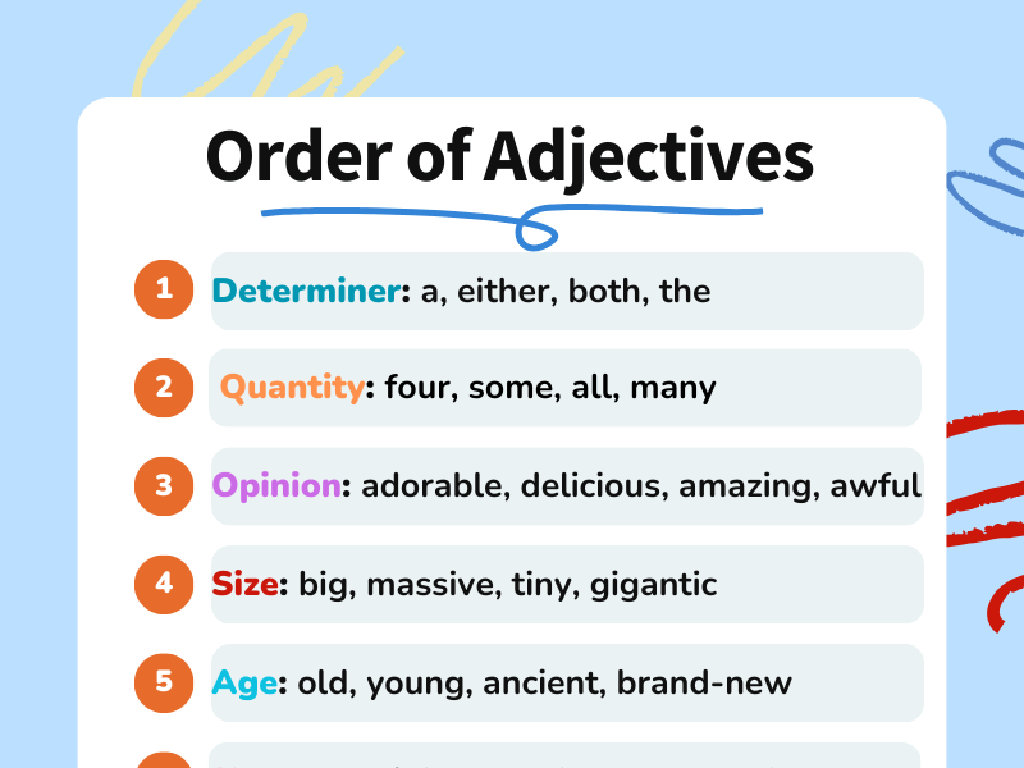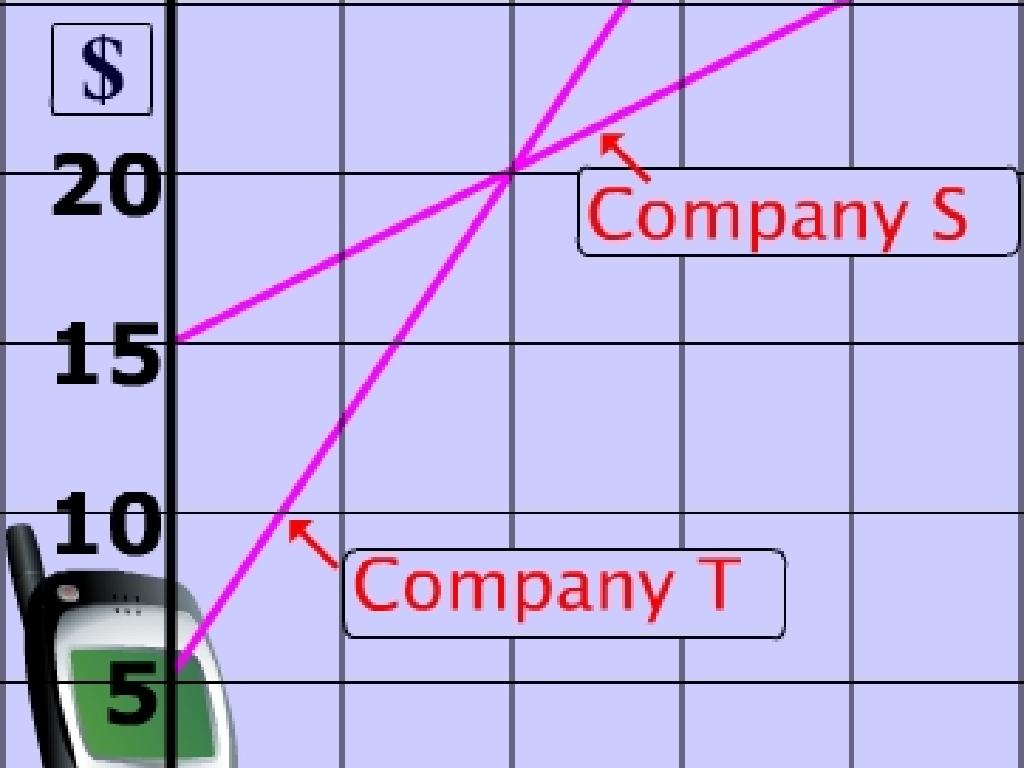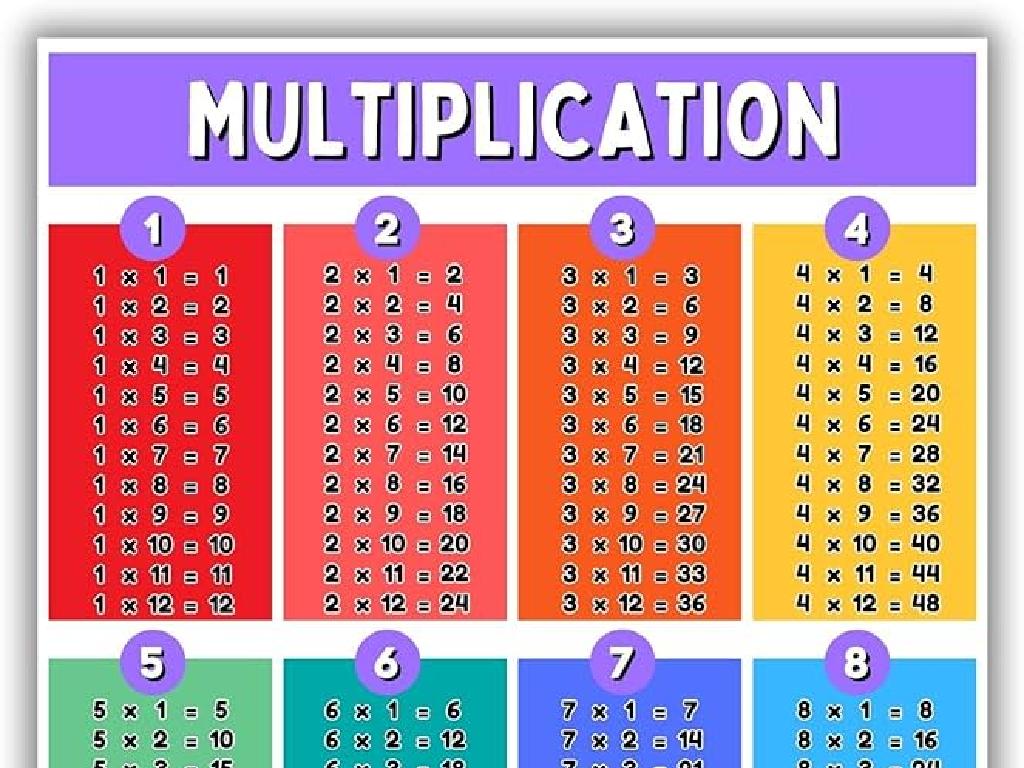Multiply Integers
Subject: Math
Grade: Seventh grade
Topic: Operations With Integers
Please LOG IN to download the presentation. Access is available to registered users only.
View More Content
Multiplying Integers
– What are integers?
– Integers include positive, negative numbers, and zero.
– Rules for multiplying integers
– Same signs multiply to positive, different signs to negative.
– Real-world integer multiplication
– Calculate profits/losses, or changes in temperatures.
– Practice problems
|
This slide introduces the concept of multiplying integers, a key skill in 7th-grade mathematics. Begin by defining integers and ensuring students understand that they include the set of whole numbers, their opposites, and zero. Explain the rules for multiplication of integers: a positive times a positive equals a positive, a negative times a negative equals a positive, and a positive times a negative equals a negative. Provide real-life scenarios where multiplying integers is applicable, such as calculating profits and losses in a business or temperature changes. End with practice problems to reinforce the concept. Encourage students to think of other real-life examples and to practice with different integer pairs.
Understanding Integers: Multiplication
– Define integers
– Integers include whole numbers, zero, and negatives
– Positive vs. Negative numbers
– Positive numbers are above zero, negatives are below
– Daily life integer examples
– Temperatures, bank balances, and elevations
– Multiplying integers
– Rules for multiplying: same signs give a positive, different signs give a negative
|
This slide introduces the concept of integers and their role in multiplication. Integers are the set of whole numbers, their opposites, and zero. Understanding the difference between positive and negative numbers is crucial for integer operations. Provide relatable examples such as temperature changes, bank account deposits and withdrawals, and above/below sea level measurements to illustrate integers in daily life. When multiplying integers, emphasize the rule that multiplying two numbers with the same sign results in a positive product, while numbers with different signs result in a negative product. Encourage students to think of real-life scenarios where they might multiply integers.
Multiplying Integers: Rules & Mnemonics
– Positive × Positive = Positive
– Positive × Negative = Negative
– Negative × Negative = Positive
– Mnemonics to remember rules
– Use phrases like ‘Good × Good = Good’, ‘Good × Bad = Bad’, ‘Bad × Bad = Good’
|
This slide is aimed at helping students understand the fundamental rules of multiplying integers. Start by explaining that multiplying two positive numbers results in a positive product. Then, discuss that a positive number multiplied by a negative number gives a negative product, and vice versa. Emphasize that two negative numbers multiplied together result in a positive product. To aid memory, introduce mnemonics such as associating ‘positive’ with ‘good’ and ‘negative’ with ‘bad’ to create simple phrases that reflect the rules. Encourage students to come up with their own creative mnemonics. Provide examples for each rule to ensure comprehension and ask students to solve similar problems to reinforce the concept.
Multiplying Integers – Let’s Practice!
– Example 1: Positive x Positive
– 3 x 4 = 12. Both numbers are positive, so the result is positive.
– Example 2: Positive x Negative
– 3 x (-4) = -12. A positive times a negative gives a negative result.
– Example 3: Negative x Negative
– (-3) x (-4) = 12. Multiplying two negatives makes a positive.
– Class Practice Activity
|
This slide is aimed at demonstrating the rules for multiplying integers through examples. Start with two positive numbers, showing that their product is also positive. Then, introduce a positive and a negative number, highlighting that the result is negative. Finally, explain that the product of two negative numbers is positive. After the examples, engage the class in a guided practice session. Provide a mix of multiplication problems and have students work in pairs or small groups to solve them. Circulate the room to offer help and ensure understanding. Possible activities could include a multiplication relay race, integer multiplication bingo, or creating a human number line to visualize the multiplication of integers.
Let’s Practice Together: Multiplying Integers
– Solve Practice Problem 1
– Example: (-3) x 4 = ?
– Tackle Practice Problem 2
– Example: 7 x (-2) = ?
– Discuss solutions in groups
– Share different methods used
– Everyone participates!
– Share your answers, ask questions
|
This slide is designed to engage students in active practice of multiplying integers. Provide two practice problems of varying difficulty to cater to different skill levels. After individual work, students will form small groups to discuss their solutions and the strategies they used. This collaborative approach allows students to learn from each other and clarify misunderstandings. Encourage all students to participate by sharing their answers and asking questions. This will create an inclusive classroom environment where every student feels valued and supported. As a teacher, facilitate the discussion, provide guidance, and ensure that each group stays on task. Possible activities include solving problems on the board, peer teaching, or creating a classroom poster with different multiplication strategies.
Multiplication and the Number Line
– Visualize multiplication on a number line
– Use arrows to show multiplication as repeated addition
– Grasp direction and magnitude
– Positive numbers move right, negatives move left
– Activity: Plot products on the number line
– Find the product of two integers and mark it on the line
|
This slide introduces the concept of visualizing multiplication of integers on a number line, which helps students understand how multiplication is essentially repeated addition. Emphasize the direction in which we move on the number line: to the right for positive numbers and to the left for negative numbers. The magnitude represents the value of the number. For the activity, provide students with pairs of integers to multiply and have them plot the resulting products on the number line. This will help them grasp the concept of positive and negative products. Possible activity variations could include using different colored markers for positive and negative numbers, or having students work in pairs to check each other’s work.
Real-world Applications of Multiplying Integers
– Temperature changes
– How temperature rises and falls with integers, e.g., -5°C to 5°C
– Financial gains and losses
– Profits (positive) and debts (negative) multiplied by factors
– Multiplication in daily life
– Apply integer multiplication to calculate changes
– Understanding positive & negative
– Grasp why multiplying two negatives makes a positive
|
This slide aims to show students how the concept of multiplying integers is relevant in everyday life. For temperature, multiplying integers can represent the transition from negative to positive temperatures, which is common in weather patterns. In finances, multiplication of integers can reflect the calculation of profits (positive integers) and debts (negative integers) over time or due to various factors. Encourage students to think of situations where they might need to multiply positive and negative numbers, such as in cooking or gaming scenarios. The goal is to help students understand that math is not just theoretical but a tool they use often without realizing it.
Class Activity: Integer Multiplication Game
– Understand the game rules
– Pair up and solve integer problems
– Work together to multiply integers, help each other out
– Share solutions with the class
– Discuss how you got your answers, learn from peers
– Reflect on the learning experience
– Think about strategies that worked and why
|
This interactive game is designed to reinforce the concept of multiplying integers. Students will pair up, which encourages collaboration and peer learning. Provide a set of integer multiplication problems for each pair. After solving the problems, pairs will share their answers and methods with the class, fostering a collaborative learning environment. Encourage students to discuss different strategies they used and to reflect on why certain approaches were effective. This activity not only solidifies their understanding of integer multiplication but also enhances their communication and critical thinking skills. Possible variations of the game could include timed challenges, competitive rounds, or incorporating physical movement by having stations around the classroom.
Review and Recap: Multiplying Integers
– Recap key lesson points
– Rules for multiplying integers, e.g., positive x positive = positive
– Quick multiplication quiz
– A few problems to test understanding
– Address unanswered questions
– Opportunity to clarify any confusion
– Reinforce learning with examples
– Use examples like -2 x 3 = -6 to solidify concepts
|
This slide aims to consolidate the students’ knowledge from today’s lesson on multiplying integers. Begin by summarizing the key points, such as the rules for multiplying positive and negative numbers. Follow with a quick quiz to assess their understanding and keep them engaged. Ensure there’s time for students to ask questions they may still have, providing a safe space for all inquiries. Conclude with additional examples to reinforce the learning objectives. For the teacher: Prepare a list of common misconceptions to address, and have extra practice problems ready for students who may need them.
Homework: Mastering Integer Multiplication
– Complete the practice problem set
– Apply concepts from today’s lesson
Use the rules for multiplying integers to solve each problem.
– Challenge yourself with extra problems
For those who finish early, attempt the bonus challenges.
– Review and prepare questions
Go over your answers and note down any uncertainties.
|
This homework assignment is designed to reinforce the day’s lesson on multiplying integers. The practice problem set includes a variety of problems that require students to apply the rules they’ve learned, such as the sign rules for multiplication. Encourage students to not only complete the set but also to challenge themselves with additional problems if they feel confident. Remind them that making mistakes is part of the learning process and to bring any questions they have to the next class. Provide a mix of difficulty levels in the problem set to cater to all students and consider offering some form of recognition for those who tackle the extra challenges.

